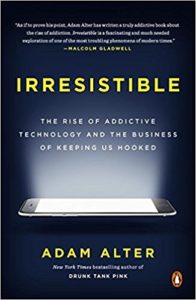“Summertime and the living is easy.” Yes, it is indisputably summertime but instead of enjoying it, many of us are as tied to our smartphones, tablets or computers as during the darkest days of winter. Even when we’re on vacation.
In his recent TEDTalk, Alan Alter, psychologist and NYU Associate Professor of Marketing, describes how excessive indulgence in screen reading has become a behavioral addiction controlling our lives. According to Professor Alter, we all work longer hours each year and many of us apparently, spend an average of three hours on our smartphones – every day.
Miraculous and wonderful as technology is, Professor Alter explains that since 2007, the approximately three hours we then dedicated to personal time, or downtime, including time we spend with family and friends, has dropped to almost nothing – a mere blip on the screen, so to speak. Usually, we’re clueless that our less than happy state is the result of this diminished personal time,
Early in his TEDTalk, he recalls an unexpected Steve Jobs’ revelation about his own family and the iPad. At the time of its release, he famously described the device as “the best browsing experience” and “extraordinary,” yet when questioned by a journalist about how his children must love it, the reply was astonishing:
— Steve Jobs commenting on his children’s use of the iPad.
No boundaries
In addition to limiting screen time, the Jobs’ family proactively used dinnertime for conversational engagement. Step into any busy food court at lunchtime and you’ll see vast numbers of people eating together. Instead of chatting, they are independently glued to small screens, even as they raise their soup spoons!
It is the absence of boundaries or what Professor Alter calls “stopping cues,” that enables endless screening. With most media today, unlike a newspaper or magazine, there are no stopping cues. The news just rolls on forever.
Work-life balance initiatives within organizations:
Europe leads the way
It was several years ago, when we first learned about some genuine efforts to sustain a healthy work-life balance. Germany’s ministry of employment banned managers from emailing or calling staff outside official business hours except in absolute emergencies. And even then, the guidelines made it clear that staff should not be penalized for failing to pick up the message.
The ministry was following precedents imposed by Volkswagen, BMW and Puma. Just 30 minutes after the workday’s end, VW stops the clock and no more emails are forwarded. The other firms make it very clear that employees are under no obligation to check emails over the weekend
According to Professor Alter, this innovative mindset continues in Germany. At Daimler, incoming emails to people on vacation are deleted. Senders are advised that the intended recipient will never, ever see the email – and to resend it in a few weeks, or email someone else!
He also describes a Dutch design firm that transforms into a yoga studio promptly at 6:00 pm. Desks are raised to the ceiling and remain suspended in space, totally inaccessible. Namaste.
Watch Adam Alter’s TEDTalk
Learn more about Adam Alter’s book: 
Irresistible: The Rise of Addictive Technology and the Business of Keeping Us Hooked
And finally, take some well-deserved downtime and listen to George Gershwin’s Summertime, with lyrics by DuBose Heyward. Composed for the 1935 debut of Porgy and Bess. Stephen Sondheim characterized these lyrics as “the best lyrics in the musical theater.” Here’s Ella Fitzgerald.


